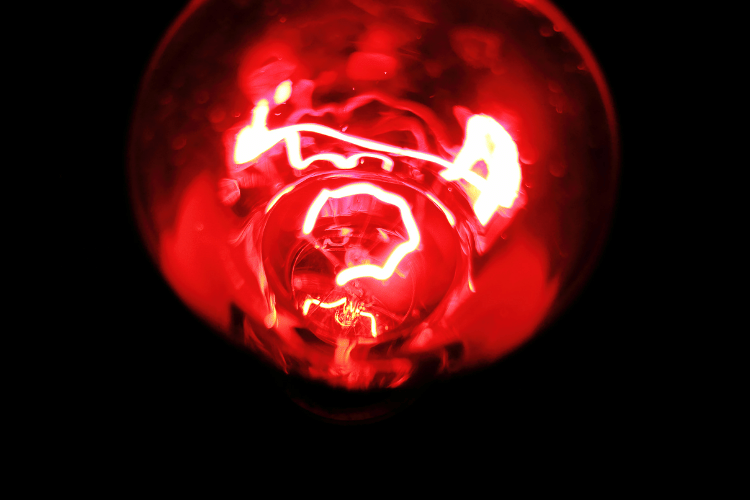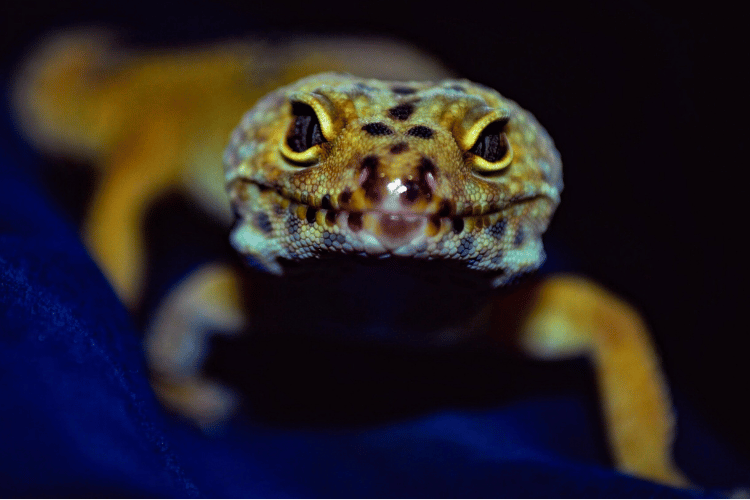Leopard geckos have become one of the most popular pet reptiles, thanks to their manageable size, docile temperament, and relatively straightforward care.
But debates continue on the best enclosure setups for these desert-dwelling lizards, especially regarding lighting and heating at night.
Many herpetoculturists use red bulbs to provide heat after dark while allowing some visibility of nocturnal behaviors. However, increasing concerns indicate red lights may profoundly disrupt a leopard gecko’s innate biological rhythms.
So, are red lights bad for leopard geckos? Read on to find out!
Understanding Red Light and Its Use
Red bulbs emit visible light from the longer wavelength red end of the spectrum. They also produce a great deal of heat, which makes them valued for heating small reptile terrariums.
Herpetoculture experts often recommend red night lights so keepers can view nocturnal species without seeming to interfere with the animal’s circadian rhythms.
Despite good intentions, however, red lighting causes numerous problems for a leopard gecko’s health, as you’re about to learn.
Why Red Lighting Causes Concerns

Here are the main potential problems associated with red lights when it comes to geckos:
Disrupting Natural Circadian Cycles
All animals, including reptiles like leopard geckos, have innate circadian rhythms regulating cycles of activity and rest.
As nocturnal creatures, leopard geckos are most active during nighttime hours. They naturally spend daylight hours sleeping or resting quietly in cool, dark spaces.
But artificial lighting at night, especially red bulbs overhead, visually disrupts these patterns, often keeping awake geckos alert when they should be sleeping.
Over time, chronically interrupted sleep severely impacts the health of any living organism, not just leopard geckos.
Heightening Stress
Leopard geckos frequently exhibit aggravated behaviors under red lights, such as pacing, hiding excessively, or refusing food.
Light pollution fundamentally alters their perception of appropriate day/night cycles, unbalancing delicate hormonal systems. Persistent unnatural lighting also strains eyes unadapted to anything beyond low light vision.
Combined, these stressors contribute to a constantly heightened baseline of anxiety and fear; a precarious state for sensitive reptiles.
Retinal Damage
While red light may seem darker and less intrusive to human eyes, it remains visible light from a reptile perspective.
Leopard geckos evolved transparent eyelids and sensitive retinal tissues adapted for low-light conditions like desert nights.
Constant exposure quickly leads to eye strain and may result in permanent retinal damage or even blindness.
Increasing Risk of Burns
Incandescent bulbs, despite being marketed for reptiles, generate a damagingly intense zone of heat compared to safer options like under-tank heating mats.
Reptiles compulsively bask in localized heat sources, often falling asleep under the intense red glow.
Gradually increasing wattage and inappropriate positioning can lead to devastating accidental burns, especially on delicate facial area tissues.
Red bulbs also excessively dry humid tropical terrariums.
Exploring More Natural Alternatives for Supplemental Heat
Thankfully, several safer alternatives now exist for providing supplemental heat at night while still respecting leopard geckos’ nocturnal adaptations.
Below are the most recommended options.
Ceramic Heat Emitters
Ceramic bulbs generate gentle heat while producing no visible light, an excellent combo for a leopard gecko’s desert origins.
Mounted over the tank, ceramics evenly warm the whole terrarium allowing leopard geckos to self-regulate across a temperature gradient.
Localized heat concentrates under the emitter for beneficial belly-warming heat leopard geckos rely on to digest foods without unnatural bright lighting.
Under Tank Heating Mats
Under-tank heating mats attach to the bottom of glass tanks like giant heated stickers. Heat passively transfers through the tank floor to gently warm the substrate where leopard geckos spend most of their time.
Their custodial heating better meets leopard geckos’ heating priorities—stable ambient and belly heat rather than a bright overhead light source.
Under-tank heaters also give leopard geckos room to move on and off the warmth as needed.
Ambient Room Temperature
As resilient reptiles, leopard geckos easily withstand slight temperature drops at night if the overall gradient across the enclosure remains stable.
Gentle heat from well-insulated room walls may sufficiently recreate the subtle desert night temperature changes.
Considering Some Common Counter Viewpoints
Advocates argue red lighting enables better visibility of fascinating nocturnal behaviors without overly disturbing routines. Some claim their particular leopard geckos showed no discernable adverse reactions.
With meticulous wattage control and positioning, red bulbs may not dangerously overheat smaller tanks. Nonetheless, red lighting remains unnatural for nocturnal species attuned to desert darkness.
For decades, expert herpetoculturists successfully raised healthy leopard geckos without supplemental night lighting or heat in climate-controlled terrariums respecting their preference for cooler nights.
When considering animal welfare, precaution trumps visibility, especially given reptiles’ specialized sensitivities.
More rigorous controlled studies on leopard geckos may further clarify species-specific impacts of red lighting. But until then, housing leopard geckos should replicate their natural ecologies as closely as possible.
This means no light, neither visible nor other broader spectrums, during hours of natural activity under cover of darkness.
What About Blue and White Light?

White light also suppresses natural melatonin production which alters delicate bio-rhythms. Even dim blue or white lighting likely causes issues like red bulbs.
No artificial light properly replicates the dark desert nights leopard geckos evolved to take advantage of. As confirmed nocturnal animals, leopard geckos need enclosures supporting resting during daylight and activity in full darkness.
Persistent lighting of any hue during nighttime will contribute to mounting stress and eventual medical problems. For their well-being, leopard geckos require completely dark nights without any bulb emitting visible light, red, blue, or otherwise.
Wrapping Up
Red lights are likely to disrupt delicate biological processes that are innate to leopard geckos’ evolutionary adaptations for desert nightlife.
More natural options like ceramics or heat mats better provide supplemental heat when needed while respecting nocturnal rest cycles essential for any animal’s health.
As our pets, leopard geckos deserve enclosures supporting natural behaviors—the cool nights of darkness that their bodies intrinsically expect after millions of years enduring stark desert cycles of sun and shadow.
Until more leopard gecko-focused studies, conscientious keepers should enable these remarkable reptiles to thrive under lighting conditions in nature intended for their niche nocturnal existence.
- Can Leopard Geckos Eat Silkworms? - March 11, 2024
- Do Leopard Geckos Climb? - March 4, 2024
- Do Leopard Geckos Bask? The Answer Will Surprise You - February 21, 2024
